|
FAQs on Anemone Identification
33
Related Articles: Anemones,
Bubble
Tip Anemones, LTAs, Cnidarians, Coldwater Anemones, Colored/Dyed Anemones,
Related FAQs: Anemone ID 1, Anemone ID 2, Anemone ID 3, Anemone ID 4, Anemone ID 5, Anemone ID 6, Anemone ID 7,
Anemone ID 8,
Anemone ID 9, Anemone ID 10, Anemone ID 11,
Anemone ID 12,
Anemone ID 13, Anemone ID 14, Anemone ID 15, Anemone ID 16, Anemone ID 17, Anemone ID 18, Anemone ID 19, Anemone ID 20, Anemone ID 21, Anemone ID 22, Anemone ID 23, Anemone ID 24, Anemone ID 25, Anemone ID 26, Anemone ID 27, Anemone ID 28, Anemone ID 29, Anemone
ID 30, Anemone ID 31, Anemone ID 32, Anemone ID 34, Anemone ID 35, Anemone ID 36, Anemone ID 37, Anemone ID 38, Anemone ID 39, Anemone ID 40, Anemone ID 41,
Anemone ID 42,
Anemone ID 43,
Anemone ID 44, Anemone ID 45,
& Cnidarian Identification, Anemones 1,
Anemones 2, Anemones 3, Anemones
4, Anemones 5, Invertebrate Identification, Aiptasia
Identification, Aiptasia ID
2, LTA
Identification, Bubble Tip
Anemones, Caribbean
Anemones, Condylactis, Aiptasia
Anemones, Other Pest
Anemones, Anemones and
Clownfishes, Anemone
Reproduction, Anemone
Lighting, Anemone Feeding,
Anemone Systems,
Anemone
Compatibility, Anemone
Selection, Anemone
Health, Anemone Behavior,
Anemone
Placement,
|
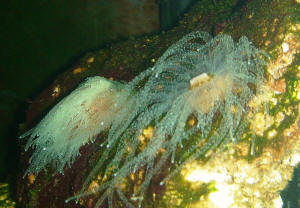
|
 |
New Print and
eBook on Amazon:
Anemone Success
Doing what it takes to keep Anemones healthy long-term
by Robert (Bob) Fenner
|
|
Anemone(?) ID 2/26/10
I set up a tank recently with rock from an aquaculture outfit in
the Gulf of Mexico near Florida, and after having the tank set up
for the past 3 weeks, I noticed a small anemone-like creature on
the rock. I asked the owner of
the outfit, and he said it was a "bead anemone".
<Mmm, what's in a (common) name? Is an
anemone/Actinarian>
Of course, Google turned nearly useless at that point, as
there's a concept in beading (necklaces and the like) called
the "anemone technique", with its' own type of
bead...
I've looked at pictures all over of Aiptasia, but this
doesn't seem to be one, as I've never seen a picture of
Aiptasia with the "bead"-type tips on the center
tentacles.
<Agreed... is likely an Anemonia species>
It's somewhere between a nickel and a quarter in size.
Another one has shown up right near it, about half the size, that
I didn't notice yesterday. The actual color is a bit redder
than it is in the picture, but that may be the coloration of the
rock altering its' color as it's semi-transparent. It has
stripes that are more white than the rest of it on all tentacles.
There's 2 types of tentacles visible. Can you ID the guy, and
point me in the right direction for information on them? Thanks a
lot!
Andrew Angrist
<Yes. Please read here:
http://wetwebmedia.com/otherpstanemfaqs.htm
and the Related FAQs files linked above. Bob Fenner>
|
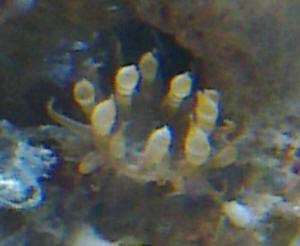 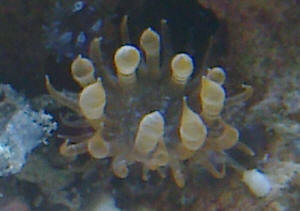 |
|
Anemone ID... and much more 2/9/10
I bought two anemones at the LFS and they were not sure as to
what species they are.
<? These animals (Actinarians) are not easily kept>
I have been successful with them in the past and I couldn't
pass up these colorful specimens. One has bright yellow/green
tips and the other has a neon green background color with purple
tentacles and a tan edge around the
whole thing. Both have an interesting zebra like pattern on the
tentacles.
They seem to get along and are now cozy next each other. My clown
won't host in them however (percula or false not sure). Any
help as to what kind of anemones these may be would be greatly
appreciated.
Thanks
Kevin
<Uhhh, need to see or have their pedicles (columns)
described... are they coloured? Smooth or otherwise
marked/distinguished? Off hand, judging by the colour, shape,
number and placement of their tentacles... the one on the left
looks like a Heteractis malu, the other possibly a H.
crispa...
Whatever they are, they are not happy... Read here:
http://www.wetwebmedia.com/marine/inverts/cnidaria/anthozoa/anemones.htm
and the linked files above. Bob Fenner>
|
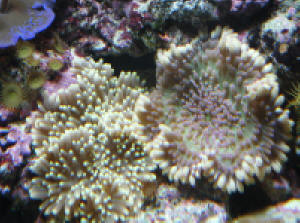
|
Re: Anemone ID
2/10/10
<... what is it with... 10 megs of pix?!>
The one anemone on the right hasn't found a spot to
settle yet.
<... READ, don't write>
The one on the left has never moved its location since I
put it there.
The one on the right (green and purple with tan edges)
landed in the corner towards the bottom but right up
against the glass so I was able to take a picture of it
from the side. I believe the other anemone looks the same
underneath as well. I know they don't have color, just
white with maybe a few small bumps. Any idea on a species
conformation with the new picture?
<Yes... a badly bleached, stung (and torn) Heteractis
crispa. See where you were referred to last time. These
animals should be returned. BobF>
Thanks
Kevin
|
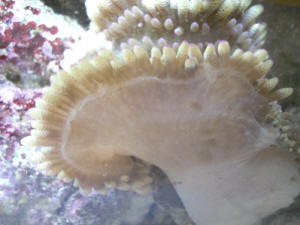 |
|
|
Anemone ID 2/7/10
Hello
<Hi there Zoe>
I bought some live rock yesterday - had quite a deep hollow in
one side - I thought there were some mushrooms in there but
couldn't really see as they were all shriveled when out of
the water. I put the lr into a holding tank and this morning have
found 4 anemones?
<Mmm, yes... appear to be Stichodactyla helianthus, the Sun
Anemone.>
have moved out of the hollow onto the front. They are all at
least 1inch x 1 inch - the tentacles extend less than 1cm - they
are quite flat, almost like a mushroom. I have had a look at the
ID pages and couldn't see much resembling them. I wondered
whether you could ID them for me and suggest whether its a good
idea to keep them or not. I have a 500l tank with a 100l sump, 3
x 54w T5s with reflectors (soon to be 4). Lots of soft
corals.
<These are very "sting-y"...>
I have attached a picture and hope I have given you enough
information.
Thanks for your time
Zoe
<Please see here on WWM:
http://wetwebmedia.com/marine/inverts/cnidaria/anthozoa/twaanemones.htm
and on the Net re their husbandry. Bob Fenner>
|
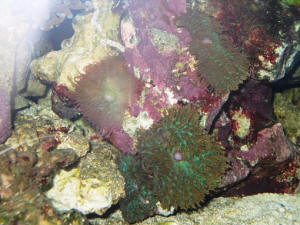 |
|
Re: Anemone ID, Helianthus
2/13/10
Thank you for time and your reply. I have tried to do some
research about the Sun Anemone and can't find too much.
<Not much about as far as I'm aware. This is not a
"traded species" of any volume, and is entirely
"too stingy" for common use>
Am a little concerned as the information I found states that they
will eat small fish (I have a couple of very small fish such as a
yellow goby, neon goby, clowns) - does this mean they aren't
safe to keep in the tank?
<Correct>
Also some of the other information says that they have a very
powerful sting - this has confused me a little because my shrimps
often walk over them / stand on them and don't react as if
they have been stung.
<These animals are indeed almost immune>
I suppose I just really want some reassurance that my fish will
be safe with them rather than me needing to give them away - what
are your thoughts?
<I would trade them to someone with a biotopic TWA shallow
water habitat.
BobF>
Thanks again for your time
|
|
Small Anemone Identification 2/3/10
Hello, my name is hunter.
<James with you today, Hunter.>
I live in sunny south Florida and have the privilege of being
able to walk the beach nearly all year round.
<I'm in Michigan currently walking in the snow and no
anemones to be found, although I do stumble upon a "snow
angel" every now and then.>
Recently I stumbled across small purplish anemone on one of my
regular trips to the beach. This one was definitely either a
juvenile or a small species, being only about an inch when she
was half open. She was rolling in the surf, so
I picked her up and looked. She appeared to have her foot torn.
Afraid she would die, I brought her home to nurse her to life.
I've had her for about a month now and she's definitely
made a complete turn around. She's always open, and eats
shrimp which I hand feed readily.
I currently have a nano 10 gallon tank set up with approximately
15 pounds live rock and one small false percula clown. My water
is pristine, ammonia and nitrite 0 and nitrate reads between 1-3
depending on if I fed that day or the day before.
Anyways, I was wondering if you could possibly ID this cute
little girl for me? I've searched and searched with no
avail.
<Appears to be a young Condylactis Anemone although I have
never saw one quite that purple. Bob has dived in these waters
and he may input here.>
Thanks so much guys!
<You're welcome. James (Salty Dog)>
Hunter.
|
 |
|
Unknown inhabitant: Aiptasia Anemone.ID and Control
2/1/2010
Well Hello!
<Hi Dani!>
I have someone living in my tank that I was hoping you could help
me ID.
<Sure.>
You can't see it very well in the pictures but this little
guy is coming out of a tube in a piece of my live rock. It goes
inside the tube if anything touches it but doesn't seem to be
bothered by movement. The tube feels kind of soft and almost
squishy to the touch. Anyway, I would like to know what it is so
that I can either remove it if it is harmful or take care of it
properly if not. Any info you can give would be very helpful.
<Looking at the pictures, it is an Aiptasia anemone. They are
pests.
Thankfully, if you catch them early, they are easy to control.
Have a read here:
http://www.wetwebmedia.com/marine/inverts/cnidaria/anthozoa/aiptasia/aiptasia.htm
for some background and read here:
http://www.wetwebmedia.com/ca/volume_1/cav1i3/aiptasia_impressions/aiptaisia_impressions.htm
for the best methods to kill them. I've found injecting them
with a Kalkwasser slurry works the best.>
Thanks much!
<My Pleasure.>
Dani
<MikeV>
|
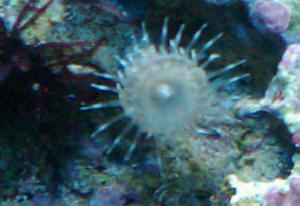 |
|
Another Anemone ID 1/22/10
Greetings again, oh great ones,
<Geez, what a title for Bob.>
So many pictures of anemones, so many possibilities. I bought
this guy as a Sebae, but I believe it to be a Carpet.
<No cigar.>
I cannot see any good close up pics of any of the different
anemones, so it is hard to determine if it is a Carpet. What
throws me off is the small tentacles that appear to be slightly
branched. Hopefully this is a clear enough picture to ID.
<Well I've scanned through all of Bob's anemone
pictures that he provided me some time ago, and my best guess is
that you have a specie of Actinodendron. Am I close Bob?
<<I do think so. RMF>>
Thanks again for all the help, for all of us!
<You're welcome. James (Salty Dog)>
Steve
|
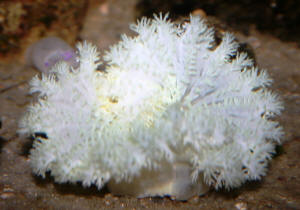 |
|
Re: Another Anemone ID
1/22/10
Not too sure on if that is the species. I have searched the web
for these and haven't found any that look even remotely like
this guy.
<Many species.>
I have read that most Actinodendron like sand/soft substrate to
anchor in. This one definitely likes to anchor on the rocks and
is staying shaded in the rocks now(may be light or water flow
preference). Also, it really has no real "branching."
On the circular disk, it has symmetrical rows of two or three
tentacles radiating out from the mouth, alternating with a gap
(also radiating outward from the mouth) before the next row. The
only "branching" is a very small bit on each tentacle,
only enough to give each a fuzzy look.
When picked up at the FS, he was happily sharing a rock with a
small Long Tentacle (they both looked happy and healthy), a few
inches apart.
I am sure we will figure this guy out, Thanks again for all the
great help,
<Mr. Fenner has also looked at your photo and he also believes
what you have is likely an Actinodendron species. James (Salty
Dog)>
Steve
|
|
Anemone... ID and more! 1/9/10
Hi guys
<and gals...>
A question for you I have recently setup a marine aquarium and
put in some live rock. A couple of <?> says alter I noticed
that this popped up it must have been hiding I the live rock. I
assume it an anemone. Is it ok as it shrivels up and has now gone
into hiding.
<Does appear to be so and so>
I got to clown fish yesterday and it still looks the same.
I've searched the web and I cant see one looking like mine.
What type is it?
<Can't be absolutely sure, but maybe an LTA,
Macrodactyla... based on the color of the pedicle mostly... Read
here:
http://www.wetwebmedia.com/marine/inverts/cnidaria/anthozoa/anemones.htm
I have attached pics. Picture 004.jpgPicture 003.jpg
Thanks
Sarah
<Read on my friend. Much to learn, apply, enjoy. Bob
Fenner>
|
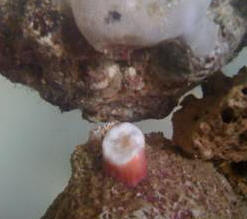 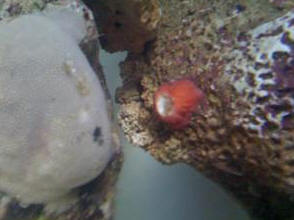 |
|
Anemone Identification 1/6/10
Hello, all:
<Hello Matthew>
I've been a long-time lurker of WWM, and thank you all very
much for your contributions to the reef-keeping knowledge
base.
<You're welcome.>
I am usually fairly adept regarding identification of things in
my tank, but this one has me stumped. I have looked through all
27 pages of Anemone ID on your site, and Google is of no use.
Here goes:
I've got a JBJ 12g Nanocube that has been up and running for
around 3 years or so. It was at first a home to a very dear
friend of mine, a G. ternatensis mantis shrimp. She was great,
but being wild caught, was unfortunately short lived (just over 2
years). The tank has since been converted to a reef. I keep
mainly LPS corals, with a few Zoanthids for good measure. Other
livestock include 1 percula clownfish, 1 cleaner shrimp, 2
blue-leg hermit crabs, a few Nassarius snails, a strawberry
anemone (the sort that lives symbiotically with hermits) an E.
quadricolor rose-tip bubble anemone. Also various stomatellids,
Vermetid snails, Asterina stars, etc. etc. A good hitch-hiker
community. I didn't buy the rose-tip anemone, it was given to
me by someone who didn't know what they were getting into,
and decided they couldn't handle it. I know 12g is way too
small for such a creature, but it seems to do okay, with fully
colored, and bubbled, tentacles. It has divided 3 times. On to
the critter(s) in question. I inspect my tank nightly, mainly
because I like to see what lurks in the darkness. About 3 weeks
ago I noticed two new anemones. Bear in mind that I have not
added anything to the tank in probably 6 months, minimum. The
first anemone is has a clear foot, along with clear tentacles,
and white tips on each tentacle. It is probably quarter-sized
when fully opened. It only comes out at night, yet is not
light-sensitive. It is not visible at all during the day. The
other anemone is quite similar, maybe related. It has the same
clear tentacles, and same while tips on them, the only difference
being a translucent orange base. I've searched the internet
to the best of my ability, and have come up with no ID's for
these two. The best I could find are ball-tip anemones from
Singapore, which I can't find genus and species information
for. Do you have any idea what they may be? I am guessing they
are juveniles.
<There are literally thousands of animals belonging to
Cnidaria, and your find may not even be an anemone but another
member of this large group.
I would give some time to let these animals grow, see if they
bud/reproduce to give a better picture as to what they might
possibly be. At that time, sending us a couple of pics would
help. Bob may shed some light/input here, but you can also look
through the photos in this link, you may find a match. Do not
limit your search to anemones.
http://guamreeflife.com/htm/inverts.htm>
Thanks very much for your help, and I look forward to your
response.
<You're welcome. James (Salty Dog)>
Matthew
Re Anemone Identification 1/6/10
Hello again:
<Hello Matthew>
Thank you, James, for the quick response.
<You're very welcome.>
I looked on the www.guamreeflife.com
<http://www.guamreeflife.com/> site, and I believe I found
a near-match:
<Was hoping that would aid you.>
http://guamreeflife.com/images/organisms/thumbs/inverts/anthozoans/actiniarians/
actinarian_spI/actinarian_spI_thumb1.jpg
Unfortunately, there is no genus or species information included
for that individual. I did come up with a bit more from a
different forum, though.
While I cannot attest to the accuracy of the post, I can say that
the critter in question is the same. The forum has identified it
as a juvenile 'Orange Ball Anemone.' Here is another
picture:
http://i51.photobucket.com/albums/f382/icyuod2/IMG_7084.jpg
<Neat, will attach to this email for Bob to post.>
<<The pic is very likely a Corallimorpharian of the genus
Pseudocorynactis. See WWM re:
http://wetwebmedia.com/mushrmidfaq2.htm
and the linked files above. BobF>>
That picture is identical to the specimen I have found. The genus
appears to be Pseudocorynactis, and species appears to be
inconclusive. What do you think about this conclusion?
<Will let Bob answer that here.>
I have read differing reports regarding this genus - ranging from
docile to fish-eating. Do you know much about the husbandry of
them?
<Likely non-photosynthetic since it only appears at night and
likely an opportunistic feeder catching whatever comes by that
it's capable of eating.
I would try putting Cyclopeeze in the evenings. Is how I feed my
Plate and Candy Cane Corals.>
Thanks in advance for your help.
Unfortunately, I don't believe I was much help. Thank you for
sharing your findings with us. James (Salty Dog)>
Matthew
|
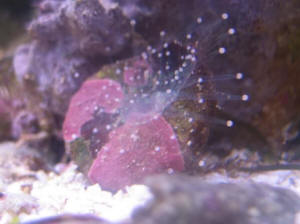 |
|
What type of anemone are these? Not searching before
writing 12/28/09
<Aiptasia likely.... read here:
http://wetwebmedia.com/aiptasiaidfaq3.htm
and the linked files above>
They came with the 'live' rock. (no idea where the vendor
has gotten the rock specifically! I think majority is from the
Caribbean).
<Very/too common>
The anemone are approximately 2-3 inches in diameter with
tentacles approx. 4-5 inches in length.
They only expand their tentacles at night.
<They'll learn to stay open during the day>
The Clarkii I have is approx. 4-5 inches in length and every once
in awhile will camp out in the larger anemone.
<Neat>
They do take brine shrimp and krill with no issues.
Tank also contains a porcupine puffer and lip-stick tang.
(55 gal. tank)
<Both of these fish species need much larger worlds. See WWM
re. Bob Fenner>
|
 |
|
|

